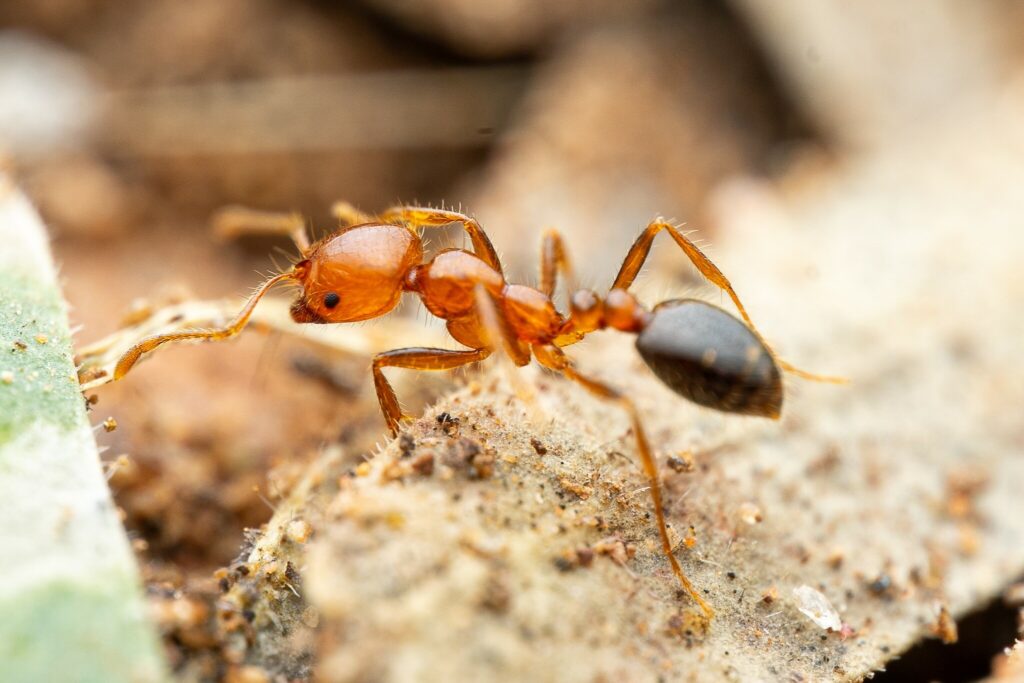Across the arid landscapes of the American Southwest, a tiny yet formidable creature has carved out its niche through remarkable adaptability and fierce territorial defense. The desert fire ant (Solenopsis xyloni), often colloquially called the Southern fire ant, has earned its fearsome reputation through painful stings, aggressive colony defense, and sophisticated social organization that rivals even our most complex human institutions. These diminutive insects, rarely exceeding a quarter-inch in length, wield disproportionate influence over their desert ecosystems and have become notorious among hikers, gardeners, and outdoor enthusiasts throughout the region. Their success in one of Earth’s most challenging environments demonstrates nature’s extraordinary capacity for adaptation, while their complex societies offer fascinating insights into collective intelligence and cooperation. This article explores the biology, behavior, and ecological significance of these remarkable desert dwellers that have mastered survival in the unforgiving Southwestern deserts.
The Desert Fire Ant’s Evolutionary History
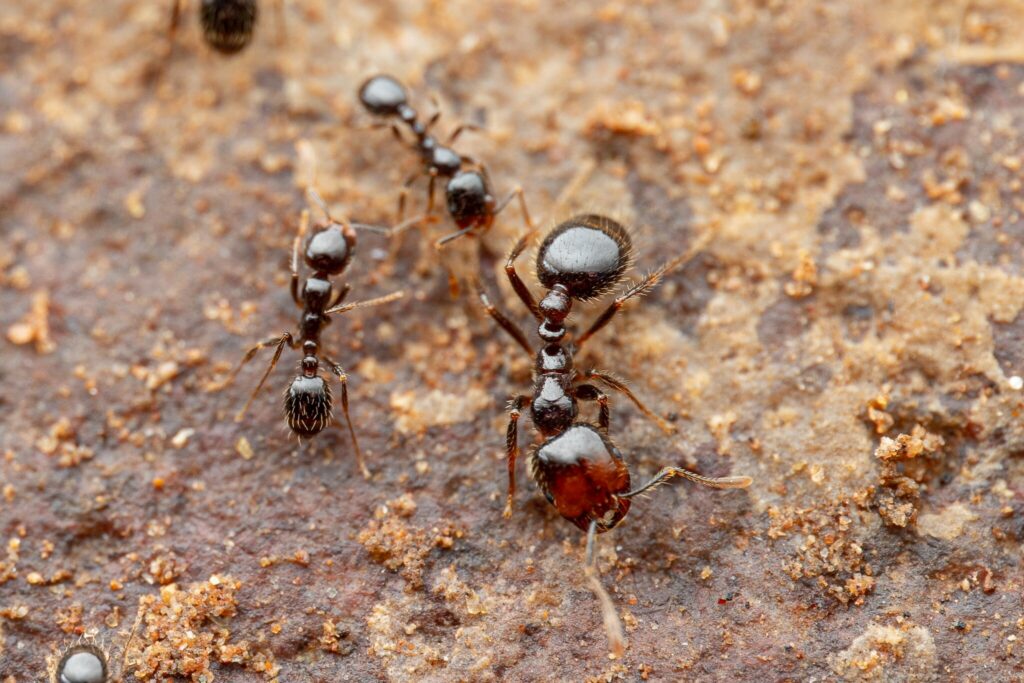
The desert fire ant belongs to the genus Solenopsis, which evolved approximately 20 million years ago during the Miocene epoch when global climate shifts created expanding arid regions. Fossil evidence suggests the ancestors of today’s desert fire ants originated in South America before gradually migrating northward as continental connections formed. Their evolutionary journey equipped them with specialized adaptations for water conservation, heat tolerance, and efficient resource exploitation in harsh environments. Unlike their infamous invasive cousins, the imported red fire ants (Solenopsis invicta), desert fire ants are native to the American Southwest, having co-evolved with the regional ecosystem for thousands of years. This extended evolutionary history has created a finely-tuned balance between these ants and their native habitat, making them integral components of desert ecology rather than destructive invaders.
Physical Characteristics and Identification
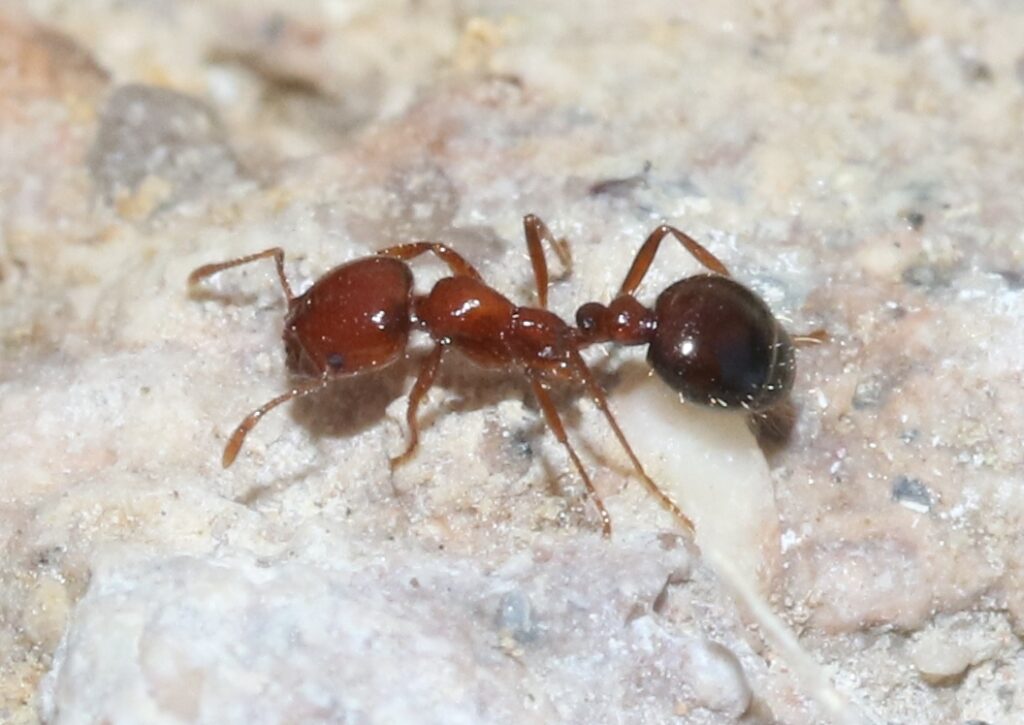
Desert fire ants exhibit polymorphism – a biological trait resulting in different physical forms within the same species. Workers range from 1/16 to 1/4 inch in length with coloration varying from reddish-brown to nearly black, often with a darker abdomen contrasting against a lighter head and thorax. Unlike some ant species with smooth contours, desert fire ants possess a distinctly segmented appearance with a clearly defined petiole (waist) consisting of two nodes when viewed under magnification. Their antennae feature a characteristic 10-segmented structure with a two-segmented club at the tip, providing enhanced chemical sensing capabilities essential for navigation and communication. Perhaps their most notorious physical feature remains hidden until threatened – a modified ovipositor (egg-laying organ) evolved into a venomous stinger capable of delivering multiple painful injections, unlike bees which can sting only once before dying.
Habitat and Geographic Distribution

Desert fire ants have carved out a remarkably successful niche throughout the American Southwest, thriving in areas where temperatures regularly exceed 100°F and annual rainfall measures mere inches. Their primary range encompasses Arizona, New Mexico, western Texas, southern Nevada, and parts of California, with populations extending into northern Mexico’s Sonoran and Chihuahuan deserts. Within these regions, they demonstrate remarkable habitat flexibility, establishing colonies in desert scrublands, grasslands, riparian zones, and increasingly in disturbed urban environments. Colony locations strategically balance between access to food resources and protection from extreme elements, often positioned near ephemeral water sources that appear after rare desert rainstorms. Urban expansion has inadvertently created favorable conditions for these adaptable insects, with irrigated landscapes and waste-rich environments providing abundant resources that have allowed populations to flourish in human-dominated spaces.
The Complex Colony Structure

Desert fire ant colonies represent marvels of biological organization, functioning as superorganisms where thousands of individuals operate in coordinated harmony toward collective survival. At the center of this social structure reigns a single reproductive queen capable of living up to seven years and producing over 1,500 eggs daily during peak breeding periods. Surrounding the queen, a complex hierarchy emerges with major workers (soldiers) featuring disproportionately large heads and powerful mandibles for defense and food processing, while smaller minor workers manage nursery duties, foraging, and nest maintenance. The colony’s reproductive future rests with alates – winged males and virgin queens that develop specifically for mating flights following seasonal rains. Most impressively, mature colonies achieve remarkable division of labor through age polyethism, where workers transition through different roles as they age, beginning with brood care and progressing to foraging and defense – all without central coordination or direct supervision.
Nest Architecture and Construction
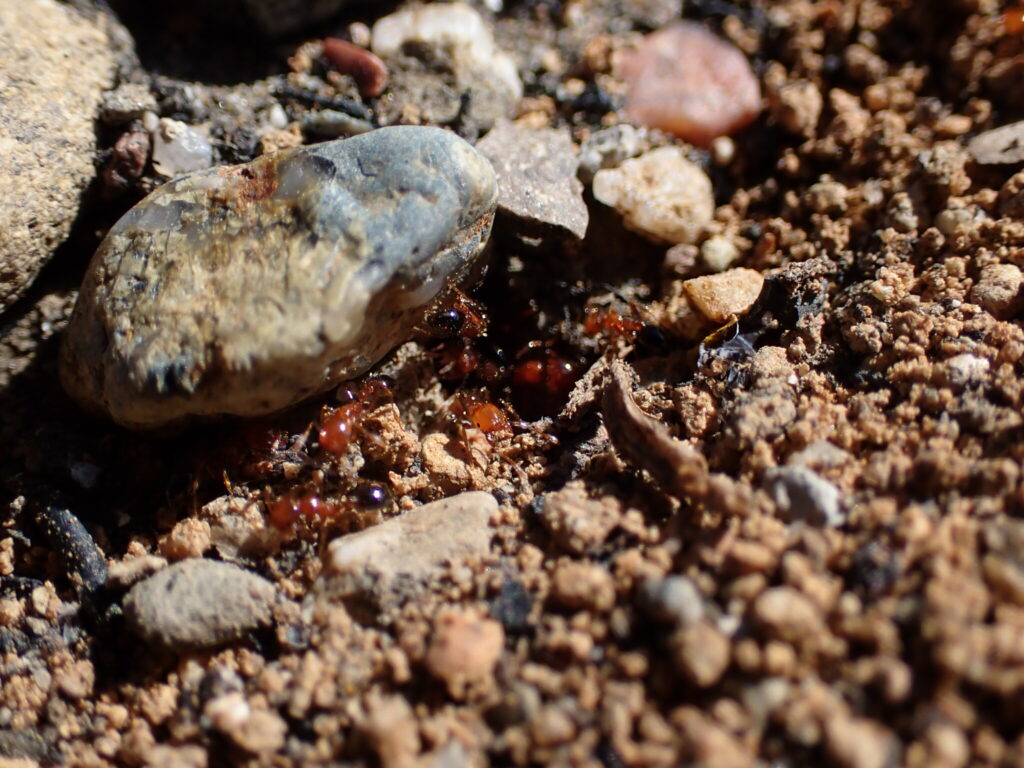
The subterranean fortresses constructed by desert fire ants represent architectural achievements that belie the builders’ diminutive size. Colony excavations typically descend 2-5 feet below the surface, with complex networks of chambers and tunnels organized into specialized functional zones. The distinctive surface mounds, composed of excavated soil particles meticulously sorted by size, serve as passive solar collectors that help regulate internal nest temperatures through the capture and retention of solar heat. These structures feature sophisticated ventilation systems with strategically placed openings that create convection currents, providing passive air conditioning that maintains optimal humidity and temperature even as external conditions fluctuate dramatically between scorching days and cool desert nights. Perhaps most impressive is the colonies’ flood-adaptation strategy – when rainwater threatens, workers rapidly link bodies to form living rafts capable of keeping the queen and brood safe until waters recede, demonstrating remarkable collective problem-solving capabilities.
The Painful Sting and Its Effects

The desert fire ant’s notorious sting delivers a venom cocktail primarily composed of alkaloid compounds called solenopsins, which trigger an immediate burning sensation followed by persistent pain disproportionate to the tiny wound size. Unlike typical insect stings that cause immediate swelling, fire ant venom produces a distinctive delayed reaction, with painful white pustules developing 24-48 hours after envenomation as immune cells respond to the foreign proteins. These pustules, while intensely itchy, should never be scratched as this can introduce secondary bacterial infections requiring medical intervention. For approximately 1% of the population with hypersensitivity to fire ant venom, stings can trigger potentially life-threatening anaphylactic reactions characterized by respiratory distress, rapid pulse, and dangerous blood pressure drops requiring immediate emergency care. Most concerning is these ants’ tendency to sting repeatedly in coordinated attacks, with a single disturbed colony capable of delivering hundreds of painful injections within seconds when threatened.
Foraging Behavior and Diet
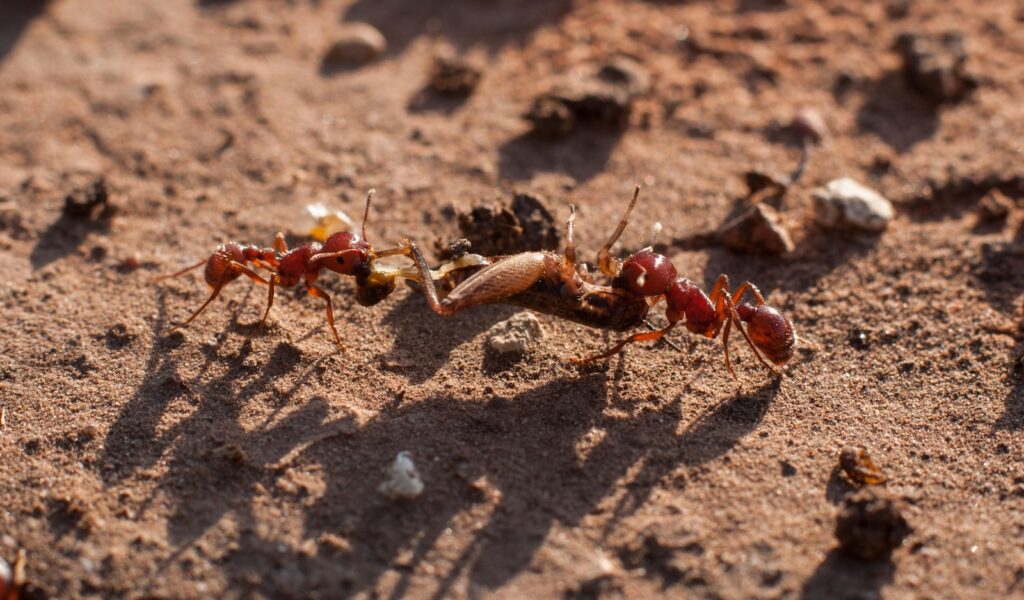
Desert fire ants employ remarkably sophisticated foraging strategies that combine individual exploration with collective decision-making to efficiently exploit available resources. Worker ants create extensive underground tunnel networks extending up to 100 feet from the main colony, serving as protected highways for resource retrieval across scorching desert surfaces. Their omnivorous diet encompasses extraordinary flexibility, from protein-rich insect prey and small vertebrates to carbohydrate-rich plant nectars, seeds, and fruits – allowing colonies to thrive through seasonal resource fluctuations. Perhaps most impressive is their chemical communication system used during foraging, where successful scouts lay pheromone trails whose strength correlates with resource quality, creating a democratic decision-making process that efficiently directs colony labor toward the most valuable food sources. This chemical democracy extends to risk assessment, with separate alarm pheromones alerting nestmates to threats and triggering coordinated defensive responses that protect valuable foraging territories from competitors.
Reproductive Strategies and Colony Expansion

The reproductive cycle of desert fire ants follows a precisely timed seasonal pattern synchronized with environmental conditions most favorable for colony establishment. When conditions become optimal, typically following summer monsoon rains, mature colonies produce winged reproductive alates – virgin queens and male drones whose sole purpose is mating and establishing new colonies. These nuptial flights, often involving thousands of reproductives from multiple colonies simultaneously, create spectacular mating swarms where males compete intensely to mate with available queens before dying shortly thereafter. Newly mated queens undergo a remarkable transformation, shedding their wings, seeking suitable nesting sites, and using stored fat reserves and metabolized wing muscles to sustain themselves while raising their first brood without foraging. This critical founding phase represents the most vulnerable period in a colony’s lifecycle, with fewer than 1% of new queens successfully establishing viable colonies, explaining why each queen mates with multiple males to maximize genetic diversity among her offspring.
Communication and Chemical Language
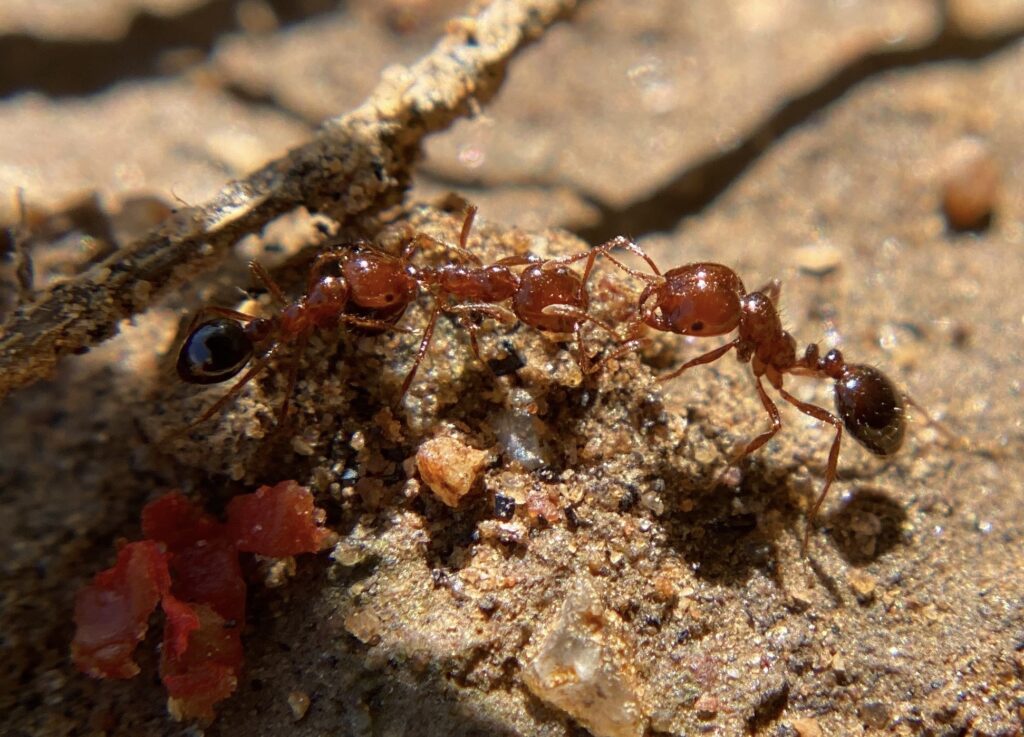
Desert fire ants employ a sophisticated chemical communication system that serves as the foundation for their complex social organization and collective decision-making. Their primary communication medium consists of pheromones – specialized chemical compounds secreted from various exocrine glands that elicit specific behavioral responses from nestmates. These chemical signals operate across at least 12 distinct functional categories, including trail marking, alarm signaling, queen recognition, nest identification, and age/caste identification. The chemical vocabulary becomes even more impressive considering that subtle variations in pheromone concentration and combinations create context-specific messages, effectively functioning as a nuanced chemical syntax. This sophisticated chemical language enables coordinated group responses without centralized control, as demonstrated when colonies rapidly mobilize thousands of workers to address threats or exploit resources based entirely on chemical information transfer. The success of this communication system becomes particularly evident during emergency responses, where appropriate chemical signals can transform the entire colony from peaceful foraging to aggressive defense within seconds.
Ecological Impact and Relationships

Despite their fearsome reputation among humans, desert fire ants function as keystone species within arid ecosystems, performing critical ecological services that maintain environmental health and biodiversity. Their extensive tunneling aerates compacted desert soils, improving water penetration and root growth while accelerating nutrient cycling through the transportation of organic materials deep into soil profiles. As voracious predators, fire ant colonies provide valuable biological control of potential pest species, particularly soil-dwelling insects that might otherwise damage native plant communities. Their seed-harvesting activities contribute significantly to plant dispersal, with colonies inadvertently planting viable seeds in nutrient-rich middens (refuse piles) that feature higher germination success than surrounding soils. The colonies themselves serve as biodiversity hotspots, creating microhabitats exploited by numerous inquiline species – specialized organisms that have evolved to live exclusively within fire ant nests, benefiting from protection, stable microclimate, and resource abundance not available in the harsh surrounding environment.
Adaptations for Desert Survival

Desert fire ants have evolved remarkable physiological and behavioral adaptations that enable their survival in one of Earth’s most challenging environments. Their water conservation capabilities include specialized rectal tissues that can extract moisture from waste materials before excretion, allowing colonies to survive extended droughts that would devastate less adapted species. Thermal tolerance mechanisms permit foraging activities at surface temperatures exceeding 120°F through specialized heat-shock proteins that prevent cellular damage at temperatures that would prove fatal to most insects. Colony architecture incorporates passive cooling systems through strategically positioned ventilation shafts that create natural convection currents, maintaining optimal internal nest temperatures despite extreme external fluctuations. Perhaps their most impressive adaptation involves behavioral flexibility around water resources – after rare desert rainstorms, colonies rapidly mobilize to collect moisture-laden materials and store them in specialized chambers, creating humidity reservoirs that sustain the colony through subsequent dry periods.
Interactions with Humans and Control Methods

Human encounters with desert fire ants typically occur when development encroaches into native habitats or when disturbance of established colonies triggers defensive responses. In agricultural settings, these ants present complex management challenges, simultaneously providing beneficial pest control while potentially damaging irrigation systems through their burrowing activities. Conventional control approaches include chemical baits containing insect growth regulators that disrupt development or metabolic inhibitors that slowly reduce colony populations without triggering dispersal responses that often follow direct pesticide application. For residential management, integrated approaches combining habitat modification (reducing moisture sources and food availability) with targeted treatments prove most effective and environmentally responsible. Those seeking non-toxic alternatives have found limited success with diatomaceous earth applications to disrupt the ants’ protective exoskeletal wax layer or boiling water treatments for accessible nests, though these approaches require precise application and typically provide only temporary relief rather than complete colony elimination.
Conservation Status and Future Prospects
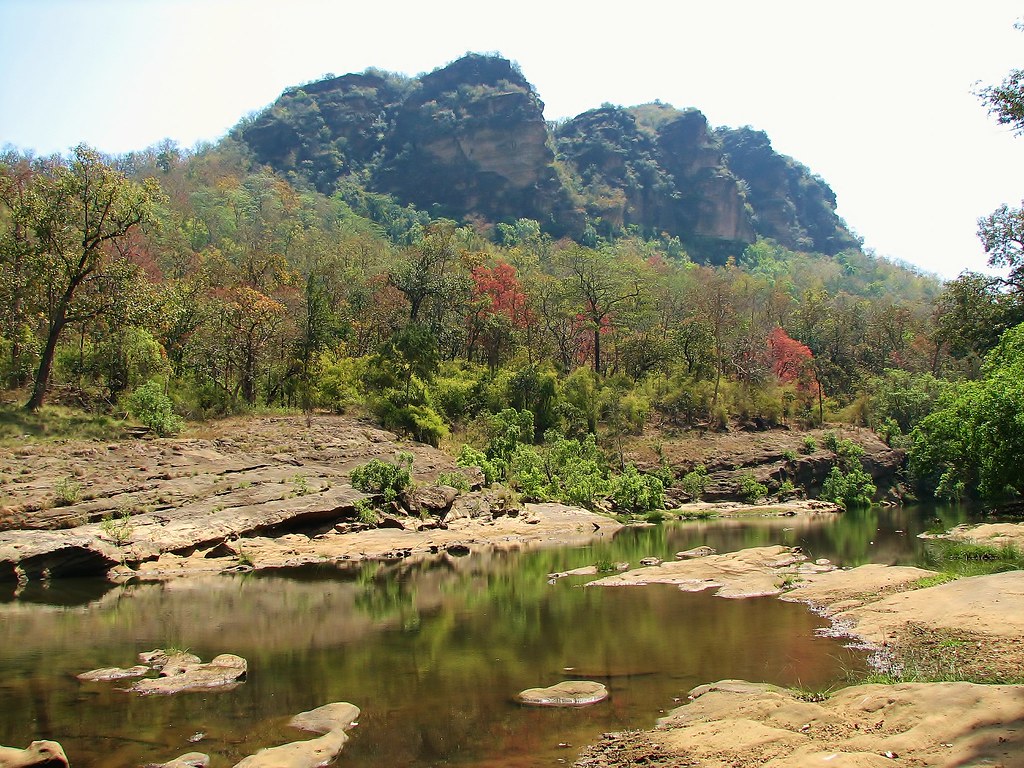
Despite their abundance in suitable habitats, desert fire ant populations face emerging challenges from climate change, habitat fragmentation, and competition with invasive species that threaten their ecological niche. Climate models predict significant habitat shifts for these ants as desertification accelerates, potentially forcing colonies into increasingly marginal territories or bringing them into greater conflict with human settlements seeking the same diminishing water resources. Perhaps the most significant threat comes from the invasive red imported fire ant (Solenopsis invicta), which has demonstrated competitive superiority in territories where the species overlap, gradually displacing native fire ant populations through more aggressive foraging and reproductive strategies. Conservation biologists increasingly recognize the ecological importance of native fire ant species, advocating for management approaches that specifically target invasive competitors while preserving native populations. The future of desert fire ants will likely depend on their remarkable adaptability, which has sustained them through millions of years of environmental challenges and may yet prove sufficient for navigating the rapidly changing landscapes of the American Southwest.
Conclusion

The desert fire ant stands as a testament to nature’s ingenuity in adapting life to extreme environments. Through millions of years of evolution, these remarkable insects have developed sophisticated social structures, communication systems, and physiological adaptations that enable their colonies to thrive where many other species struggle to survive. While their painful stings and aggressive defense make them unwelcome neighbors for many Southwestern residents, their ecological contributions through soil improvement, seed dispersal, and pest control represent valuable services that maintain healthy desert ecosystems. As climate change and habitat disruption accelerate, understanding these resilient natives becomes increasingly important for conservation efforts and sustainable management practices. The desert fire ant, with its complex societies and remarkable adaptations, offers valuable insights into biological success through cooperation – powerful lessons from tiny teachers that have mastered the art of desert survival through collective effort and evolutionary innovation.

